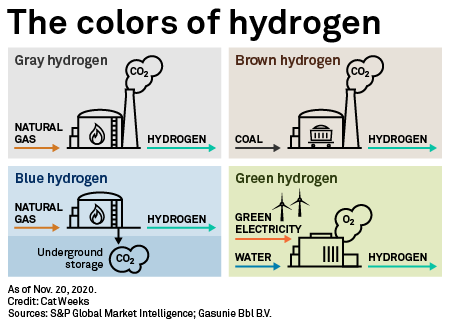S&P Global Offerings
Featured Topics
Featured Products
Events
S&P Global Offerings
Featured Topics
Featured Products
Events
S&P Global Offerings
Featured Topics
Featured Products
Events
Banking & Capital Markets
Economy & Finance
Energy Transition & Sustainability
Technology & Innovation
Podcasts & Newsletters
Banking & Capital Markets
Economy & Finance
Energy Transition & Sustainability
Technology & Innovation
Podcasts & Newsletters
S&P Global Offerings
Featured Topics
Featured Products
Events
30 Jun, 2021

By Bill Holland
Norwegian oil and gas producer Equinor ASA is teaming up with manufacturer U.S. Steel Corp. to explore converting Appalachia's natural gas to cleaner "blue hydrogen," the firms said June 29.
Blue hydrogen uses steam methane reforming to make hydrogen and uses carbon capture and storage, or CCS, technologies to store the waste carbon, usually underground. Natural gas is typically the feedstock for steam methane reforming.
 |
Combined, Pennsylvania, northern West Virginia and eastern Ohio produce more natural gas than Texas. Another source of local demand would be welcomed by Appalachia's producers. When pipelines out of the region fill up, Appalachia's shale gas producers often end up selling gas into the glutted local market at a large discount to national prices.
Equinor and U.S. Steel said the non-exclusive memorandum of understanding would open the door to studying the potential for producing and selling blue hydrogen in the region, as well as to combining their lobbying efforts with policy makers. Theoretically, just as natural gas replaced coal for many steelmaking processes, hydrogen could replace gas, reducing potent methane and carbon dioxide emissions.
"A hydrogen and CO2 hub in the Appalachian Basin, utilizing the region's natural gas resources while capturing and safely storing the emissions, would be an important tool to meet the future energy demands of domestic industry within the U.S. ambition to achieve net-zero by 2050," Equinor's U.S. country manager, Chris Golden, said in a statement.
The key to net-zero emissions globally is not to eliminate carbon-intensive industry sectors but instead, make them less intensive, protecting jobs and infrastructure," Equinor's executive vice president for exploration and production international, Al Cook, told an audience June 28 at the Washington, D.C.-based Atlantic Council.
"We're leading a project called Zero Carbon Humber, which at the moment is the world's largest blue hydrogen project, and that's looking at decarbonizing an industrial cluster, the U.K.'s largest industrial cluster in northeast England," Cook said. "For all that renewable energy can bring forward green jobs, it's vitally important that we also protect jobs that have been created around steel, around cement, around heavy industry. And we protect that by decarbonizing those industries, rather than eliminate them."
Cook hinted that as hydrogen developed, Equinor would combine renewable electricity from its wind projects offshore New York and New Jersey with water to create green hydrogen for the U.S. market. "We intend to bring clean hydrogen to the northeast of the United States to join up with the clean electrons that we'll be bringing from our offshore wind projects," Cook said.
Equinor still has active wells and exploration and production operations in Appalachia. The company is trying to divest itself of its U.S. shale oil and gas operations as part of its plan to become a net-zero carbon emitter by 2050.
